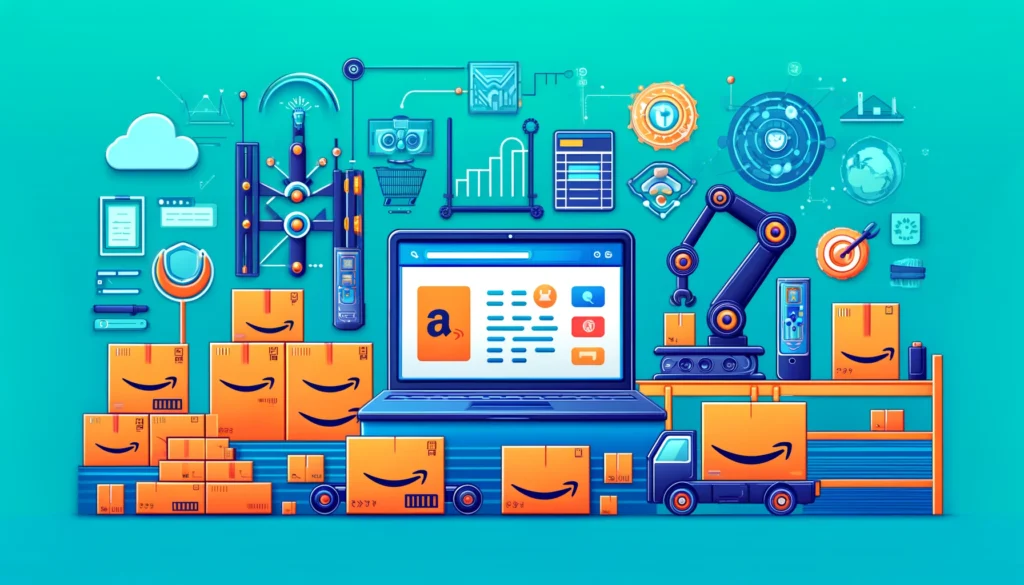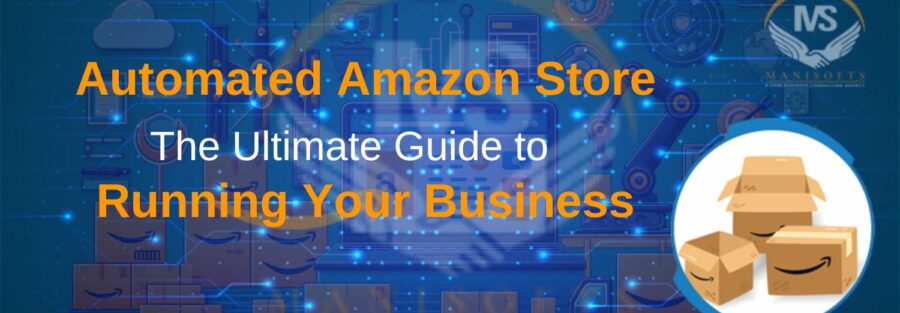Discover how automation can simplify tasks, enhance efficiency and trigger sales for your Amazon store. Find out about main automation areas, necessary tools as well as approaches to get started.
Introduction
In the present fast-moving world of eCommerce there are always Amazon sellers who want an advantage. This is where an automated Amazon store comes in; allowing technology to take over so that you can streamline operations while still having time for strategic growth. What this means is using software together with other instruments in order to do all those boring jobs like keeping track of inventory levels or setting prices automatically depending on demand among others thus freeing up more hours for personal development or thinking about what else needs improvement within their business model altogether.
Automated amazon Store
With every passing day, automated Amazon stores are becoming the future of businesses across different industries especially e-commerce. Picture this: a store that makes money whiles you sleep and requires minimal hands-on management from merchants’ part – isn’t it amazing? But thanks to technological advancements, dreams like these have already been realized.
What is an Automated Amazon Store?
An automated Amazon store refers essentially to any online retail operation which utilizes software tools as well as services designed specifically for running most aspects involved in daily activities pertaining to selling products on amazon such ecommerce platform product listing optimization pricing strategy etcetera . Such tasks may include but not limited to; listing items adjusting prices based on demand managing stock levels fulfilling orders handling customer service issues even doing promotions through various channels like email marketing platforms among others. By automating these processes one can save much effort needed when handling them manually thereby freeing more time for thinking strategically towards growing their business.
The Magic Behind the Automation
1. Product Sourcing and Listing:
Wholesale and Private Labeling: Automation tools may identify profitable products, streamline listing processes, and manage bulk inventories better. Wholesale involves purchasing items in large quantities from manufacturers at discounted rates before reselling them; private labeling lets one create their own brand by buying generic items then marketing them under self-brand name.
2. Inventory Management:
Stock levels are tracked with automation software which also automatically reorders when they run low while updating listings to show what’s presently available. This prevents those “out of stock” situations that can hurt sales and upset customers’ satisfaction most. RestockPro or InventoryLab will do just fine especially considering how strong their features are for managing inventories effectively.
3. Pricing Strategies:
Dynamic pricing tools change prices according to competition, demand among other market factors so as not only maximize profits but also help keep one step ahead of competitors hence maximizing returns on investment too.. Such measures ensure competitiveness in pricing thus enabling more sales volumes realization within short durations such RepricerExpress plus Informed.co whose functionality allows real-time adjustments based on current data about similar products being sold elsewhere.
4. Order Fulfillment:
Automation makes everything even easier especially if done through FBA where Amazon does storage, packing & shipping jobs for you while syncing stores automatically using fulfillment centers located across regions should ensure smooth flow during processing orders thereby saving lots of time besides tapping into large logistics network offered by this giant online retailer called Amazon itself.
5. Customer Service:
Customer inquiries, returns, and reviews are managed by automated customer service tools. Quick and efficient support is provided by chatbots and response systems that use AI to deal with frequently asked questions and problems. To give seamless customer support, platforms such as Zendesk or Freshdesk can be integrated with your Amazon store.
6. Marketing and Advertising:
Your campaigns are handled by automated advertising platforms which optimize them to get the best return on investment. Data is analyzed by these software from PPC ads to social media promotions while adjusting strategies in real-time. Helium 10 and Jungle Scout not only help you with the research of products but also provide powerful marketing tools for boosting visibility of your products too.
Benefits of an Automated Amazon Store
- Time Saving: This saves time and lets you concentrate on growing a business or having more free time. Instead of wasting your energy doing the same thing over and over again, one can engage in strategic planning and development.
- Scalability: Growing a business becomes easier with automation. Higher sales volumes can be managed even without additional work. This advantage is essential when there are many orders during peak seasons.
- Affordability: Automation reduces the number of staff required thereby lowering operational costs. In addition to this efficient processes means lesser mistakes made and less returns done which saves money in long term basis as well. The saved funds from manual labor reduction could be used elsewhere within an organization.
- Consistency: When tasks are consistently performed through automated systems they become more accurate leading to improved overall performance levels besides customer satisfaction enhancement too. Such uniformity also plays a part in creating strong brand reputation since buyers get predictable shopping experience every time.
- Data-Driven Decisions: Usefulness of automation tools lies in the insights it provides alongside analytics that aids decision making process based on facts rather than assumptions alone. Sales trends can be monitored while tracking customer behavior together with stock levels thus enabling proper adjustment as well as optimization of strategies where necessary.
Getting Started with Your Own Automated Store
- Select the Appropriate Tools: Research and find the most appropriate automation systems for your business. Some well-liked alternatives include Jungle Scout, Helium 10, and Sellics. These provide different functions from advertising optimization through product research to inventory management.
- Keep Up to Date: Never forget that e-commerce is dynamic in nature. Therefore, ensure that your store remains competitive by staying informed about the latest trends, tools and strategies. To be precise; follow industry blogs, attend webinars or even network with other sellers thus keeping track ahead of time.
- Optimize and Iterate: Regularly assess how well your shop performs against set targets; if need be use automation insights gained in order to optimize listings based on pricing or even marketing efforts made. Come up with new tactics frequently after reviewing existing ones vis-a-vis their performance records so as maximize efficiency alongside profitability.
- Reviews are important too!: Customer feedback can help a great deal especially when it comes from those who have already purchased such services before us – but sometimes we don’t always get what was expected thereby leading into negative comments being posted online about our company’s reputation itself alone without elaborating more details behind them… Take advantage of automated reviews tracking toolkits which not only monitor these statements but also provide channels where clients air their views regarding various products offered by merchants within this platform at large scale then address every issue raised positively without ignoring any single one because they may act as stepping stones towards improving what needs fixing within our organizations no matter how small they might seem at first sight..
- Diversity!: Try adding more things into it! Like adding colours or something else like colourful widgets.. As long as an automated store gets efficient then product lines should be expanded accordingly. What is needed most here are data-driven decisions whereby one can tell which items sell better together with those that complement each other hence increasing the value of your store overall to customers.
- Sell Everywhere: You don’t have to sell on Amazon only, try different platforms too. Sell everywhere using automation tools such as Shopify, eBay and Walmart which help in managing sales across multiple channels. By doing so you will be able to reach out more people who might never even think about visiting Amazon but love shopping from other sites like ebay for example.. thereby creating an additional revenue stream while at it..
- Keyword Stuffing: Come up with relevant keywords, high-quality images as well as detailed product descriptions which should not only improve visibility but also attract more customers through SEO strategies implemented both for general search engines and Amazon’s search algorithm itself
Automated Amazon stores represent a significant leap forward in e-commerce. They offer a blend of convenience, efficiency, and scalability that can transform the way you do business. Whether you’re a seasoned entrepreneur or just starting, embracing automation could be your key to success in the ever-evolving online marketplace. By leveraging the power of automation, you can streamline operations, boost profitability, and position your business for long-term growth in the competitive world of e-commerce.
How does an amazon automated store work?

An Amazon automated store, often referred to as an Amazon FBA (Fulfillment by Amazon) business, involves setting up an online store where Amazon handles the storage, packaging, and shipping of products. Here’s a step-by-step breakdown of how it works:
1. Product Research and Selection:
- Market Research: Identify profitable niches and products by analyzing market trends, competition, and demand.
- Supplier Sourcing: Find reliable suppliers, often through platforms like Alibaba, to source products.
2. Listing Creation:
- Product Listing: Create detailed product listings on Amazon with descriptions, images, keywords, and other relevant information.
- Optimization: Optimize listings with SEO-friendly keywords to improve visibility and ranking on Amazon search results.
3. Inventory Management:
- Stock Management: Maintain adequate inventory levels to meet demand without overstocking.
- Shipping to Amazon: Send your products to Amazon fulfillment centers. Amazon then stores these products in their warehouses.
4. Order Fulfillment:
- Customer Orders: When a customer places an order, Amazon picks, packs, and ships the product directly to the customer.
- Shipping Options: Amazon offers various shipping options, including Prime, which ensures faster delivery.
5. Customer Service and Returns:
- Customer Support: Amazon handles customer inquiries and support for orders fulfilled through FBA.
- Returns and Refunds: Amazon manages returns and refunds, providing a hassle-free experience for customers.
6. Marketing and Sales:
- Advertising: Use Amazon’s advertising platform (Amazon PPC) to promote your products and drive sales.
- Promotions: Run promotions and discounts to attract customers and increase sales.
7. Analytics and Optimization:
- Performance Tracking: Monitor sales performance, customer reviews, and inventory levels using Amazon’s seller tools.
- Optimization: Continuously optimize product listings, marketing strategies, and inventory management based on analytics.
8. Fees and Costs:
- Amazon Fees: Pay various fees to Amazon, including FBA fees, referral fees, and storage fees.
- Profit Margins: Calculate profit margins after considering product costs, shipping fees, Amazon fees, and advertising expenses.
Benefits of an Amazon Automated Store:
- Scalability: Easy to scale up by adding more products without worrying about logistics.
- Customer Trust: Leverage Amazon’s brand reputation and trust.
- Prime Eligibility: Offer fast shipping options to attract Prime members.
- Global Reach: Access to a vast customer base across different regions.
Challenges:
- Competition: High competition on the Amazon marketplace.
- Fee Structure: Managing various fees and costs to maintain profitability.
- Inventory Management: Balancing inventory levels to avoid stockouts or overstocking.
An Amazon automated store allows entrepreneurs to focus on product selection and marketing while Amazon handles logistics and customer service, making it a popular choice for many online sellers.
Amazon automated store investment
Investing in an Amazon automated store has become an increasingly popular strategy for those seeking to generate passive income through e-commerce. This approach leverages automation technologies to handle key business functions such as product sourcing, listing optimization, inventory management, order fulfillment, and customer service. Here’s a detailed look at why investing in an Amazon automated store can be a smart financial move.
Initial Investment Requirements
- Automation Software: Investing in quality automation software is crucial. Tools like Jungle Scout, Helium 10, and InventoryLab can assist with product research, inventory management, and sales analytics.
- Inventory Purchase: A significant portion of the initial investment will go towards purchasing inventory. It’s important to conduct thorough market research to select products with high demand and good profit margins.
- Amazon Seller Fees: There are various fees associated with selling on Amazon, including referral fees, fulfillment fees, and subscription fees for a professional seller account.
- Marketing and Advertising: Effective marketing strategies, such as Amazon PPC (Pay-Per-Click) campaigns, are essential for driving traffic to your store and boosting sales.
- Operational Costs: These may include costs for packaging, shipping, and any additional services like virtual assistants or third-party fulfillment centers.
Risk Management and Mitigation
While the potential for passive income is high, it’s important to acknowledge and manage the risks associated with an Amazon automated store investment. These risks include market competition, changes in Amazon policies, supply chain disruptions, and technological issues with automation tools. Having a diversified product portfolio, staying updated with Amazon’s guidelines, and maintaining strong supplier relationships can help mitigate these risks.
FAQ’s
The initial investment can vary widely but generally includes costs for purchasing inventory, setting up automation tools, Amazon seller fees, and potentially hiring virtual assistants. A rough estimate could range from a few thousand to tens of thousands of dollars.
Yes, anyone can set up an Automated Amazon Store, but it requires a basic understanding of e-commerce, Amazon’s seller policies, and the ability to invest in automation tools and initial inventory. Some prior experience in online retail can be beneficial.
To maintain profitability, regularly monitor key performance metrics, optimize product listings, manage inventory effectively, and stay updated on market trends. Continuously refining your product selection based on sales data is also crucial.
Potential risks include changes in Amazon’s policies, increased competition, supply chain disruptions, and reliance on automation tools that may have technical issues. Mitigating these risks involves staying informed and having contingency plans.
The timeline for seeing results can vary based on factors like niche selection, product demand, and marketing efforts. Some store owners may start seeing sales within a few weeks, while for others, it might take several months to achieve significant revenue.
Conclusion
An Automated Amazon Store represents a modern approach to e-commerce that leverages automation technology to streamline business operations. By minimizing manual tasks and maximizing efficiency, this business model allows entrepreneurs to focus on strategic growth and scaling their store. While the initial investment in tools and inventory can be substantial, the potential for passive income and reduced operational burden makes it an attractive option for those looking to enter the e-commerce space.
Success with an Automated Amazon Store requires careful planning, market research, and ongoing optimization, but with the right approach, it can be a highly rewarding venture. As the e-commerce landscape continues to evolve, automated solutions will likely play an increasingly significant role in shaping the future of online retail.



